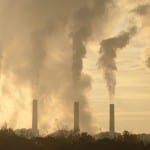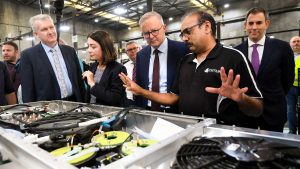 The Abbott government and leading business figures in northern Queensland have thrown their support behind a proposal to spend $1.8 billion on a new coal-fired generator in the region. Which might sound like a good idea, as long as you close your eyes and ears.
The Abbott government and leading business figures in northern Queensland have thrown their support behind a proposal to spend $1.8 billion on a new coal-fired generator in the region. Which might sound like a good idea, as long as you close your eyes and ears.
A $2.5 million study – supported by the state and federal governments, and championed by independent MP Bob Katter – suggests that an 800MW generator using “low quality” coal in the Galilee Basin would deliver an economic “social cost benefit gain” of $836 million.
It’s absolute bollocks, of course, and it relies on a whole host of hazy assumptions. One is for government support for a transmission line, another is for government “protection” against a future carbon price, and the other is the ability to source cheap coal from one of the giant Galilee Basin coal projects, whose development is under great doubt because of declining international coal forecasts and plunging international coal prices. And it’s hard to find anywhere in the 1,000 page (one thousand, I kid you not) report where it seriously considers the environmental negatives of such a development.
The report – North and North West Queensland Sustainable Feasibility Studies – looks at a stand-alone coal generator, and its role within a broader scheme to introduce irrigated farmland. It’s a complex and detailed report, but what stands out is the analysis on energy.
As an example, one of the biggest benefits cited in support of coal generation is its ability to add more capacity to the wholesale market and therefore bring prices down. The Queensland government did that more than a decade ago when it built new coal and gas fired generators, but doesn’t like it now that renewables are having the same impact. Extraordinarily, this report dismisses an alternative plan to include a 500MW solar project, partly because it would bring those prices down too far. In combination with rooftop solar, it says it would shift the peak to the early evening and lower prices in the afternoon.
The report suggests that the 800MW coal fired generator is intrinsically linked with the assumed development of the huge Galilee Basin, and demand from those mines for electricity, as well as a supplier of cheap coal.
It also draws in the role that a coal-fired power station, or renewable alternatives, could play in the established of irrigated farming schemes in the region. Among the scenarios considered are a smaller coal plant or a bagasse biomass plant, accompanied by wind, and a “high renewable scenario” where 500MW of wind and 500MW of solar are added.
It suggests that the economic case for wind and solar falls off dramatically, and in the case of solar could subtract more than $1 billion from the value of such a project. But is assumptions are based on a number of contestable cost estimates.
For instance, it puts the capital cost of solar PV at $2,500 a kilowatt. That’s probably about 50 per cent above most current estimates and experience. Interestingly, it is using numbers prepared by ACIL Allen which is doing the modelling for the federal government’s controversial RET Review. According to the table used for this document, ACIL Allen expects the capital cost of solar PV to remain at $2,400/kW even in 2040. Most market forecasts expect it to be a fraction of that price.
As this graph shows, this translates into the production cost of solar being up to 50 per cent more than it would be in three years. The estimates of wind are also way above market price, at around $1,900 per kilowatt. The actual price, represented by the about to be completed Snowtown 2 project, is closer to $1,600/kW.
Even more astonishingly, the calculations “do not project entry of utility-scale solar PV in any region of the NEM prior to 2040”. Presumably their research did not extend to the discovery of the 153MW solar project currently under construction in NSW by AGL, or the 40MW being built in three projects in the ACT, not to mention numerous other projects in the pipeline. 2040 is a long, long way away to assume no solar.
It says that under all three scenarios modelled, the solar component significantly degrades the overall project NPV result – by as much as $1.2 billion under the “traditional policy” scenario, which relies on the assumption that carbon price and other environmental mechanisms are removed, and remain so for the life of the plant.
The cost assessment also flies in the face of most independent analysis that suggests coal fired generation would be far more expensive than wind energy mostly because of the high financing costs caused by carbon policy uncertainty and its environmental implications and impacts.
It is difficult imagining any financial institution lending money to such a project. Already, banks such as Deutsche Bank and HSBC are saying they will not finance the Abbot Point coal port which would take the Galilee coal. Australian bankers privately say they want nothing to do with it, and Bendigo Adelaide Bank has publicly rejected investments in coal generation.
This issue is recognised to a certain extent in the feasibility study.
“The environmental and social challenges of developing a coal-fired power station may prove to be significant barriers for some investors,” it notes.
But that’s no hurdle, though, because it suggests this could be overcome by providing government support and subsidies
“… Although the project is commercially viable in the presence of a carbon price, future very-high or unexpected carbon prices may threaten viability. If the Australian governments wished to assist in managing this carbon price risk it could consider providing some level of protection against future unexpected or very-high carbon prices for important projects through legislation, or contractual arrangements.”
And the report suggests that the government could pay for part of the $200 million plus transmission line, and that the development of a baseload coal fired power station could be linked to any sale of the Ergon Energy retail electricity business.
“A unique opportunity exists for the Queensland Government to include in the sale proposition for EEQ a right (with some degree of development obligation) to develop a base load coal-fired power station of a similar nature to the power station project.”
There are a whole lot of other issues not addressed in the report – such as what happens to a 40-year coal plant if the Galilee Basin coal mines die, where is the water sourced for cooling? And who is going to finance it?
Despite all this, the idea has the enthusiastic support of acting Prime Minister Warren Truss, even though the government is seeking to remove such support for renewables across the country.
He has also got the backing from local business and industry groups in the area, who see baseload coal as the only possible answer. But with information like this, it is a case of the ignorant being led by the uninformed.
Little wonder that the proponents of renewable generation are throwing their hands up in the air. Regional Development Australia, in a submission to the RET Review panel, pointed to more than $1 billion of wind and solar projects at risk if that policy is removed or reduced.








